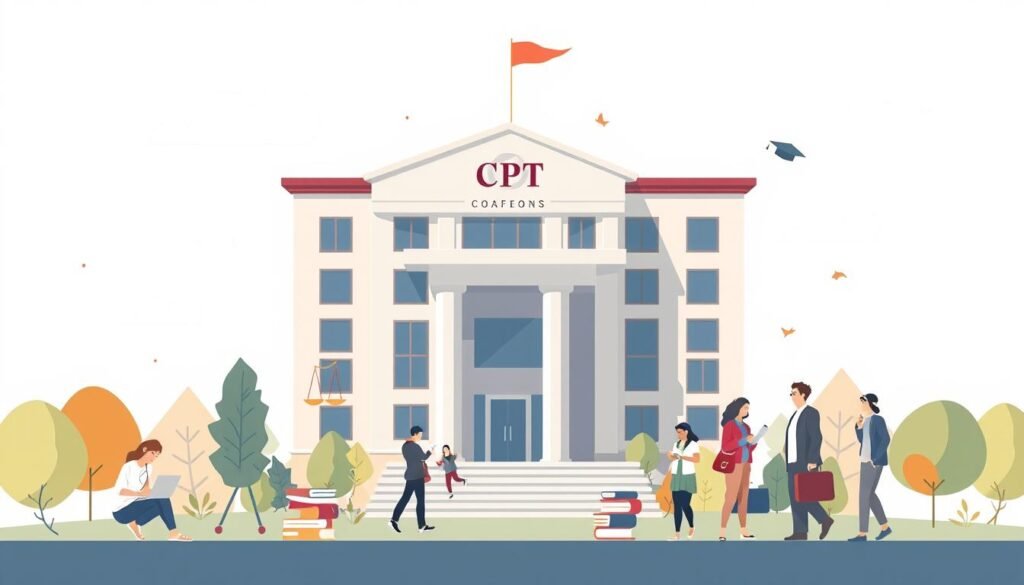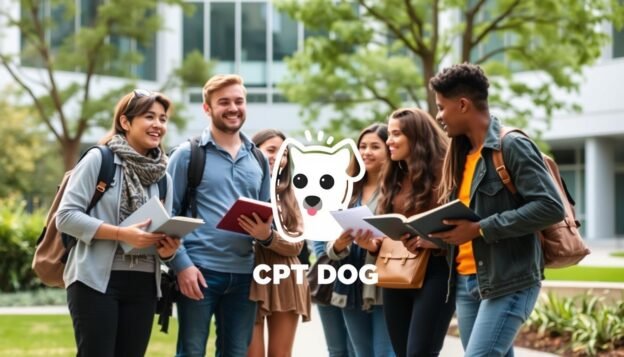If you’re an international student on an F-1 visa, you might wonder is day 1 cpt legal. It sounds interesting, but is Day 1 CPT legal? The truth is in how universities follow USCIS rules to make sure their Day 1 CPT programs are okay.
Only a few schools let students start using Day 1 CPT right when they begin their graduate studies. It’s key to know the legal side of this. Designated School Officials (DSOs) check if you’re eligible and if your program meets USCIS standards. The University of Farmington case shows the dangers of fake Day 1 CPT programs. It’s vital to pick schools that follow the law.
Dealing with visas, work permits, and school rules can be tricky. But, schools with real Day 1 CPT programs can give you work experience and help you get a job in the U.S. Learning about the legal side of this chance can help you choose wisely for your studies and career.
Key Takeaways:
- IS Day 1 CPT legal – work option for F-1 visa students, but it must follow USCIS rules closely.
- Universities decide who can use Day 1 CPT through Designated School Officials (DSOs), making sure students are in approved programs.
- The University of Farmington case shows the dangers of fake Day 1 CPT programs, so it’s important to choose a trusted school.
- Real Day 1 CPT programs can give international students valuable work experience and help them get jobs in the U.S.
- It’s crucial for international students to understand the legal side of Day 1 CPT to make smart choices for their studies and careers.
Understanding Day 1 CPT: An Overview
The world of international student education in the United States is complex. It includes rules like the Curricular Practical Training (CPT) program. Day 1 CPT is a special option for F-1 students. It lets them start work-based learning on their first day, unlike the usual one-year wait.
What is Day 1 CPT?
Day 1 CPT is a part of U.S. immigration rules for some graduate programs. It’s different from regular CPT, which needs a year of study first. Day 1 CPT lets students work right when they start their studies.
Purpose of Day 1 CPT in Education
The main goal of Day 1 CPT is to mix work experience with school. It’s great for graduate programs that need students to start working early. This helps students learn by doing from the start.
Who is Eligible for Day 1 CPT?
- Graduate and doctoral students in programs needing early internships or work.
- Students must keep their F-1 status and make sure the work fits their study field.
- The university’s DSO checks if a student can join based on program needs and USCIS rules.
Knowing about Day 1 CPT helps international students make the most of their U.S. education. They can start learning and growing their careers right away.
The Legal Framework Surrounding Day 1 CPT
International students need to know the legal rules of Day 1 Curricular Practical Training (CPT) to work in the U.S. from the start of their studies. Day 1 CPT is legal under certain conditions. But, the rules can be tricky, and schools must follow them closely to avoid problems.
Key Regulations by USCIS
The U.S. Citizenship and Immigration Services (USCIS) manages Day 1 CPT. But, their exact rules are not clear on their website. Schools must create policies that follow immigration laws. They need to make sure Day 1 CPT fits with the student’s studies and follows crypto pump and dump, USCIS policies, and F-1 visa regulations.
University Policies and Procedures
- Designated School Officials (DSOs) decide on Day 1 CPT, not USCIS. So, schools must be very careful.
- Schools must keep detailed records of the job. This shows it’s connected to the student’s study field.
- Keeping accurate records and talking clearly with students is key to a good Day 1 CPT program.
Differences Between CPT and OPT
| Characteristic | CPT | OPT |
|---|---|---|
| Timing | Occurs during the academic program | Can occur during or after the academic program |
| Duration | Day 1 CPT starts immediately; traditional CPT requires one academic year completion | Typically 12 months, with a possible 24-month extension for STEM students |
| Purpose | Curricular, directly related to the student’s field of study | Provides practical experience in the student’s field of study |
It’s vital for international students and schools to understand Day 1 CPT’s legal side. This helps them deal with the program’s complexities and follow USCIS policies and F-1 visa regulations.

Best Practices for Universities Offering Day 1 CPT
Universities must follow best practices for Day 1 Curricular Practical Training (Day 1 CPT). This includes aligning the program with academic curricula. They also need to keep detailed records and work with legal experts. This helps support international students while following university rules.
Alignment with Academic Programs
Universities should make sure Day 1 CPT fits into their academic plans. They should offer a full course of study, not just online classes for F-1 students. The work experience should match the student’s field of study, as the law requires.
Documentation and Record-Keeping
Keeping detailed records is key for following Day 1 CPT rules. Schools need to keep track of job offers, I-94 forms, CPT agreements, and tuition payments. They also must record attendance and make sure students meet all course requirements, as the U.S. Department of Homeland Security says.
Collaboration with Legal Experts
Universities should work with immigration lawyers and legal experts. These professionals help understand the law, create strong policies, and answer questions from international students.
| Key Regulation | Requirement |
|---|---|
| 8 CFR § 214.2(f)(10)(i) | CPT must be a fundamental part of the established curriculum |
| U.S. Department of Homeland Security | CPT is accessible to F1 visa holders who have completed at least a full year of study, with exceptions for graduate programs |
| Code of Federal Regulations | Graduate and higher-level programs can engage in internships or work from the first semester without fulfilling the first-year requirement |
By following these best practices, universities can make sure crypto trading is legal. They can also ensure a good experience for international students.
Common Misconceptions About Day 1 CPT
As an F-1 international student, dealing with trading strategies and F-1 student work authorization can be tough. Many think Day 1 Curricular Practical Training (Day 1 CPT) is open to all students. But, it’s only for certain graduate programs, and each university has its own rules.
Another big mistake is thinking Day 1 CPT doesn’t affect your immigration compliance. The U.S. Citizenship and Immigration Services (USCIS) might doubt your F-1 status if your CPT job doesn’t match your studies. Breaking these rules can hurt your chances for future visas or green cards.
It’s key to know the difference between legal CPT and illegal work. Understanding these rules helps you make smart choices and avoid big problems.
Risks of Non-Compliance
Day 1 CPT is a great chance for international students to get work experience. But, ignoring the rules can cause big problems. These include:
- USCIS questioning your F-1 status
- Issues with future visas or green cards
- Legal and financial troubles for you and your university
Working with your university’s international student office and legal advisors is crucial. This ensures your Day 1 CPT job meets academic needs and keeps your F-1 status.
Clarifying CPT vs. Unauthorized Employment
Many confuse authorized and unauthorized work with Day 1 CPT. Authorized CPT is legal for international students, but only if it follows USCIS rules. Unauthorized work, like working without permission or too many hours, can ruin your F-1 visa.
It’s important to know the difference between these jobs and follow the rules. By staying informed and working with your university, you can use Day 1 CPT wisely and benefit from it.

How to Check if Your University Complies with Day 1 CPT Regulations
As an international student, it’s key to check if your university follows Day 1 CPT rules. Knowing the laws and best practices helps you choose the right path for your studies and career.
Evaluating University Credentials
When looking at universities, make sure to check their accreditation and how they handle international student resources. Look up the U.S. Department of Education’s website to see if the university is accredited. Also, read online reviews and student stories to learn about their Day 1 CPT programs.
Resources for Students
- Look at the university’s website for info on international student support and CPT policies.
- Learn about USCIS guidelines on CPT to know your rights as an F-1 visa holder.
- Talk to an immigration attorney who knows about international student issues for more advice.
Asking the Right Questions
When checking if a university follows Day 1 CPT rules, ask these questions:
- Is the program STEM-focused, as these might offer Day 1 CPT chances?
- Do you need to attend classes on campus, or can you do CPT online?
- How does CPT fit with your classes and study plan?
- Where is the university, and how easy is it to find CPT jobs?
By doing your homework and asking the right questions, you can find a university that meets Day 1 CPT rules. This way, you’ll get the support you need for your studies and career.
Consequences of Improper Day 1 CPT Use
Using day 1 CPT the wrong way can lead to big legal problems for international students. Going to schools that offer day 1 CPT without following the rules can cause visa problems. This can lead to being kicked out of the country and make it hard to get visas in the future.
Schools that break the rules can also face big troubles. They might lose their right to give out I-20 forms, get fined a lot, or even face criminal charges.
The University of Farmington case is a warning. It was a fake school set up by the U.S. government. People were arrested for visa fraud because they helped students get jobs through day 1 CPT. This shows how important it is to follow the rules and keep a good name in the U.S. immigration system.
Legal Ramifications for Students
- Visa revocation and potential deportation
- Accrual of unlawful presence leading to 3-year or 10-year entry bans
- Difficulties in future immigration processes, including denied visa applications
Institutional Consequences for Universities
- Loss of ability to issue I-20 forms, which are necessary for international student enrollment
- Substantial fines imposed by the U.S. government
- Criminal charges for universities found to be operating fraudulent day 1 CPT programs
Importance of Compliance in Maintaining Reputation
Following day 1 CPT rules is key for both students and schools. Keeping a good name is vital in U.S. higher education. Breaking the rules can hurt the reputation of both students and schools.
“Compliance with day 1 CPT regulations is not only a legal requirement but also a matter of preserving the integrity of international education in the United States.”
Future of Day 1 CPT in American Education
The demand for work experience among international students is growing. This makes the future of Day 1 CPT programs in American education very interesting. These programs have given students valuable skills. But, the USCIS’s closer watch has raised worries about rule changes.
Trends in International Student Employment
Day 1 CPT is becoming more popular among international students. They want to mix their studies with real-world training. This shift shows a growing need for practical skills in education.
But, USCIS’s stricter rules might make these programs harder to access. Universities will have to deal with more complex rules.
Potential Changes in Regulation
USCIS might change rules for Day 1 CPT. They want to fight visa fraud. This could mean universities have to be more open and work closely with legal experts.
This could lead to more rules for these programs. It might also mean more chances of getting Requests for Evidence (RFEs) during the H-1B approval process.
The Role of Advocacy Groups and Student Organizations
Advocacy groups and student organizations are key in shaping Day 1 CPT’s future. They can push for fair policies that balance training and academic integrity. This way, international students can still get these valuable chances.
By working with policymakers and universities, these groups can help shape the rules. They can make sure the education system stays strong while giving students the best opportunities.
